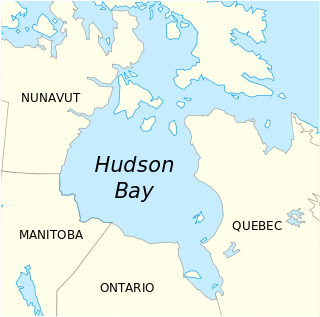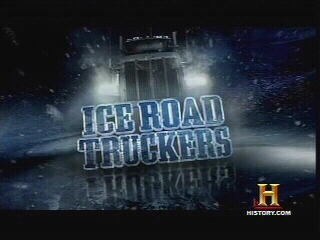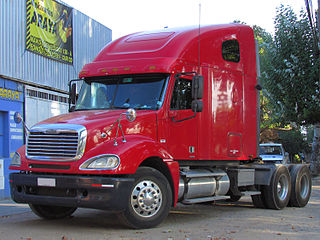
A semi-trailer truck is the combination of a tractor unit and one or more semi-trailers to carry freight. A semi-trailer attaches to the tractor with a fifth-wheel coupling (hitch), with much of its weight borne by the tractor. The result is that both the tractor and semi-trailer will have a design distinctly different from that of a rigid truck and trailer.

A truck or lorry is a motor vehicle designed to transport cargo. Trucks vary greatly in size, power, and configuration; smaller varieties may be mechanically similar to some automobiles. Commercial trucks can be very large and powerful and may be configured to be mounted with specialized equipment, such as in the case of refuse trucks, fire trucks, concrete mixers, and suction excavators. In American English, a commercial vehicle without a trailer or other articulation is formally a "straight truck" while one designed specifically to pull a trailer is not a truck but a "tractor".

A road train or land train is a trucking vehicle of a type used in rural and remote areas of Australia, the United States and in Europe to move freight efficiently. It consists of two or more trailers or semi-trailers hauled by a prime mover.

A snowmobile, also known as a motor sled, motor sledge, skimobile, snowscooter, or snowmachine, is a motorized vehicle designed for winter travel and recreation on snow. It is designed to be operated on snow and ice and does not require a road or trail, but most are driven on open terrain or trails. Snowmobiling is a sport that many people have taken on as a serious hobby.
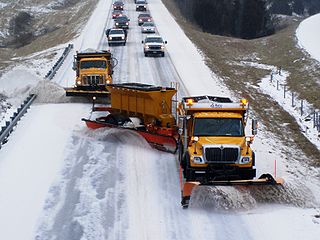
A snowplow is a device intended for mounting on a vehicle, used for removing snow and ice from outdoor surfaces, typically those serving transportation purposes. Although this term is often used to refer to vehicles mounting such devices, more accurately they are known as winter service vehicles, especially in areas that regularly receive large amounts of snow every year, or in specific environments such as airfields. In other cases, pickup trucks and front end loaders are outfitted with attachments to fulfill this purpose. Some regions that do not frequently see snow may use graders to remove compacted snow and ice off the streets. Snowplows can also be mounted on rail cars or locomotives to clear railway tracks.

Snow removal or snow clearing is the job of removing snow after a snowfall to make travel easier and safer. This is done by both individual households and by governments and institutions.

A truck driver is a person who earns a living as the driver of a truck.

Rail freight transport is the use of railroads and trains to transport cargo as opposed to human passengers.
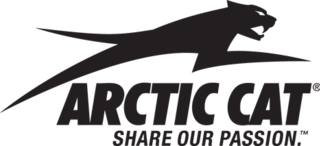
Arctic Cat is an American brand of snowmobiles and all-terrain vehicles manufactured in Thief River Falls, Minnesota. The company was formed in 1960 and is now part of Textron Inc. The company designs, engineers, manufactures and markets all-terrain vehicles, snowmobiles, as well as related parts, garments—such as snowmobile suits—and accessories.

Vehicular automation involves the use of mechatronics, artificial intelligence, and multi-agent system to assist a vehicle's operator. These features and the vehicles employing them may be labeled as intelligent or smart. A vehicle using automation for difficult tasks, especially navigation, may be referred to as semi-autonomous. A vehicle relying solely on automation is consequently referred to as robotic or autonomous. After the invention of the integrated circuit, the sophistication of automation technology increased. Manufacturers and researchers subsequently added a variety of automated functions to automobiles and other vehicles.

A winter service vehicle (WSV), or snow removal vehicle, is a vehicle specially designed or adapted to clear thoroughfares of ice and snow. Winter service vehicles are usually based on a dump truck chassis, with adaptations allowing them to carry specially designed snow removal equipment. Many authorities also use smaller vehicles on sidewalks, footpaths, and cycleways. Road maintenance agencies and contractors in temperate or polar areas often own several winter service vehicles, using them to keep the roads clear of snow and ice and safe for driving during winter. Airports use winter service vehicles to keep both aircraft surfaces, and runways and taxiways free of snow and ice, which, besides endangering aircraft takeoff and landing, can interfere with the aerodynamics of the craft.
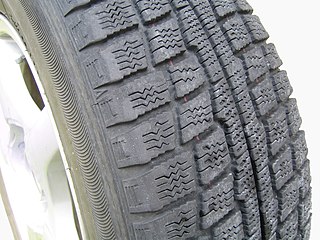
Snow tires—also called winter tires—are tires designed for use on snow and ice. Snow tires have a tread design with larger gaps than those on summer tires, increasing traction on snow and ice. Such tires that have passed a specific winter traction performance test are entitled to display a "Three-Peak Mountain Snow Flake" symbol on their sidewalls. Tires designed for winter conditions are optimized to drive at temperatures below 7 °C (45 °F). Some snow tires have metal or ceramic studs that protrude from the tire to increase traction on hard-packed snow or ice. Studs abrade dry pavement, causing dust and creating wear in the wheel path. Regulations that require the use of snow tires or permit the use of studs vary by country in Asia and Europe, and by state or province in North America.

An articulated hauler, articulated dump truck (ADT), or sometimes a dump hauler, is a very large heavy duty type of dump truck used to transport loads over rough terrain, and occasionally public roads. The vehicle usually has all-wheel drive and consists of two basic units: the front section, generally called the tractor, and the rear section that contains the dump body, called the hauler or trailer section. Steering is made by pivoting the front in relation to the back by hydraulic rams. This way, all wheels follow the same path, making it an excellent off-road vehicle.

Tibbitt to Contwoyto Winter Road is an annual ice road first built in 1982 to service mines and exploration activities in the Northwest Territories and Nunavut in Northern Canada. Between 400 and 600 km long, the road is said to be the world's longest heavy haul ice road and operates for eight to ten weeks starting in the last week of January. Most of the road (85%–87%) is built over frozen lakes, 495 km (308 mi), with the remaining 73 km (45 mi) built on over 64 land portages between lakes. This ice road was the location of the first season of Ice Road Truckers.

The Lombard Steam Log Hauler, patented 21 May 1901, was the first successful commercial application of a continuous track for vehicle propulsion. The concept was later used for military tanks during World War I and for agricultural tractors and construction equipment following the war.
The V/Line RTL class is a road-rail locomotive, capable of operating on both road and rail. It was basically a truck with retractable rail wheels. Built by Western Star Trucks in the United States, the rail equipment was provided by Brandt Industries of Canada.

On March 9, 2015, an Amtrak passenger train derailed in Halifax, North Carolina, after colliding with a truck carrying an oversize load that was obstructing the line at a grade crossing. There were no fatalities, but 55 people were injured.

Winters Brothers is a privately held waste disposal business in the Northeast United States. Its headquarters are in Westbury, New York; it currently serves the markets of New York and Connecticut, but previously also served Florida and Vermont. It sells its recovered products worldwide. It is the largest waste management firm in Long Island, and one of the largest in Connecticut. The firm has six recycling centers and twelve transfer stations.


